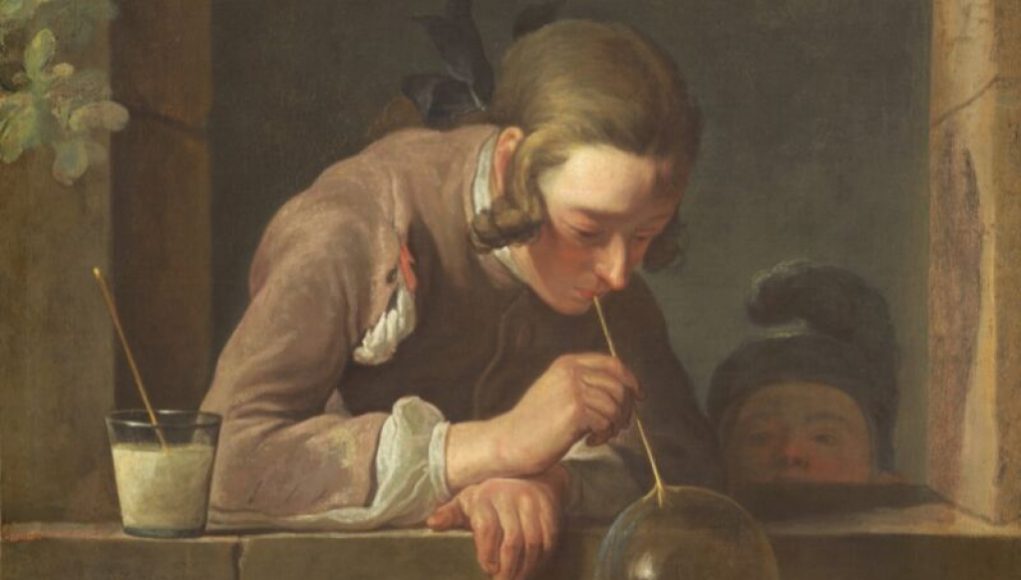Get ready to pop your bubble of ignorance about bubbles! French painters Jean Siméon Chardin and Édouard Manet both created famous paintings of children blowing bubbles through straw-like tubes, and now two physicists at the Université Grenoble Alpes in France have conducted their own soap bubble experiments to learn more about the early formation stages of bubble dynamics. In a forthcoming paper to be published on May 22 in the journal Physical Review Fluids, they describe their findings and how they were inspired by the realistic depictions of bubble dynamics in Chardin and Manet’s paintings.
Bubbles may seem like child’s play, but there is actually some complex physics behind them. In the 1800s, Belgian physicist Joseph Plateau outlined four basic laws of surface tension that determine the structure of soapy films. Surface tension is why bubbles are round; that shape has the least surface area for a given volume, so it requires the least energy to maintain. Over time, that shape will look more like a soccer ball than a perfect sphere as gravity pulls the liquid downward (“coarsening”).
But the study of bubbles is not just ancient history. In recent years, physicists and mathematicians have made significant strides in understanding the formation and properties of bubbles. In 2016, French physicists worked out a theoretical model for the exact mechanism for how soap bubbles form when jets of air hit a soapy film. In 2018, mathematicians at New York University’s Applied Math Lab fine-tuned the method for blowing the perfect bubble based on a series of experiments with thin, soapy films. And in 2019, physicists at MIT and Princeton University demonstrated how to develop spherical bubbles uniformly by confining them in a narrow tube.
Scientists are interested in forming bubbles with a uniform size and shape, like the liquid droplets that form from a dripping faucet. This could help control the formation of drops and bubbles in applications such as microfluidics, inkjet printing, or medical imaging. However, droplet and bubble formation are inverse physical processes, and bubbles formed by injecting air or gas into a large vat of liquid will be more random and scattershot.
The co-authors of the forthcoming paper, Marc Grosjean and Elise Lorenceau, were particularly intrigued by bubbles that linger when attached to a straw-like tube instead of pinching off, as depicted in Chardin and Manet’s paintings. The physicists conducted their own experiments to learn more about the factors underlying bubble formation, particularly in the less-studied early stages. So next time you blow a bubble, remember that there’s more to it than meets the eye!
French painters have recently been the starting point for new insights into the physics of soap bubbles – unlocking potential applications for such breakthroughs in cosmetics, everyday products and the medical industry.
Since the 17th century, French painters such as Jean-Baptiste-Siméon Chardin and Antoine Watteau have captured the aesthetic beauty of soap bubbles in their artwork. Yet, these delicate orbs encapsulate a wealth of secrets that have escaped the scientific community for centuries. That is, until now.
Researchers at the Institute of Biological and Environmental Sciences in Paris were the first to decode the mystery of why certain soap bubbles form perfect, six-sided polygons in mid-air. As they tested and reviewed the work of French painters, they identified a fundamental principle behind the formation of these geometric structures, known as Laplace forces, which states that they emerge due to air pressure and the surface tension of the bubble itself.
In terms of practical applications, understanding the physics of soap bubbles has been critical in advancing cosmetic products. For example, thanks to these findings, scientists are now able to create extremely stable foams, minimising the high levels of evaporation typically associated with current products, leading to a much longer shelf-life.
Furthermore, these breakthroughs could have the potential to be used in several medical applications, such as bubble-based drug delivery and targeted intravenous emulsions. Dr Bastien Box, a consultant at the Institute, said “these findings open up the possibility of applying soap bubbles in many more ways than we currently can – and it is all thanks to the legendary French painters who first captivated us with their beautiful visuals.”
Unravelling the physics of soap bubbles has been an eye-opening venture for scientists who are now beginning to see the beauty in art and a future for French painters in the development of everyday products and medical treatments.




















